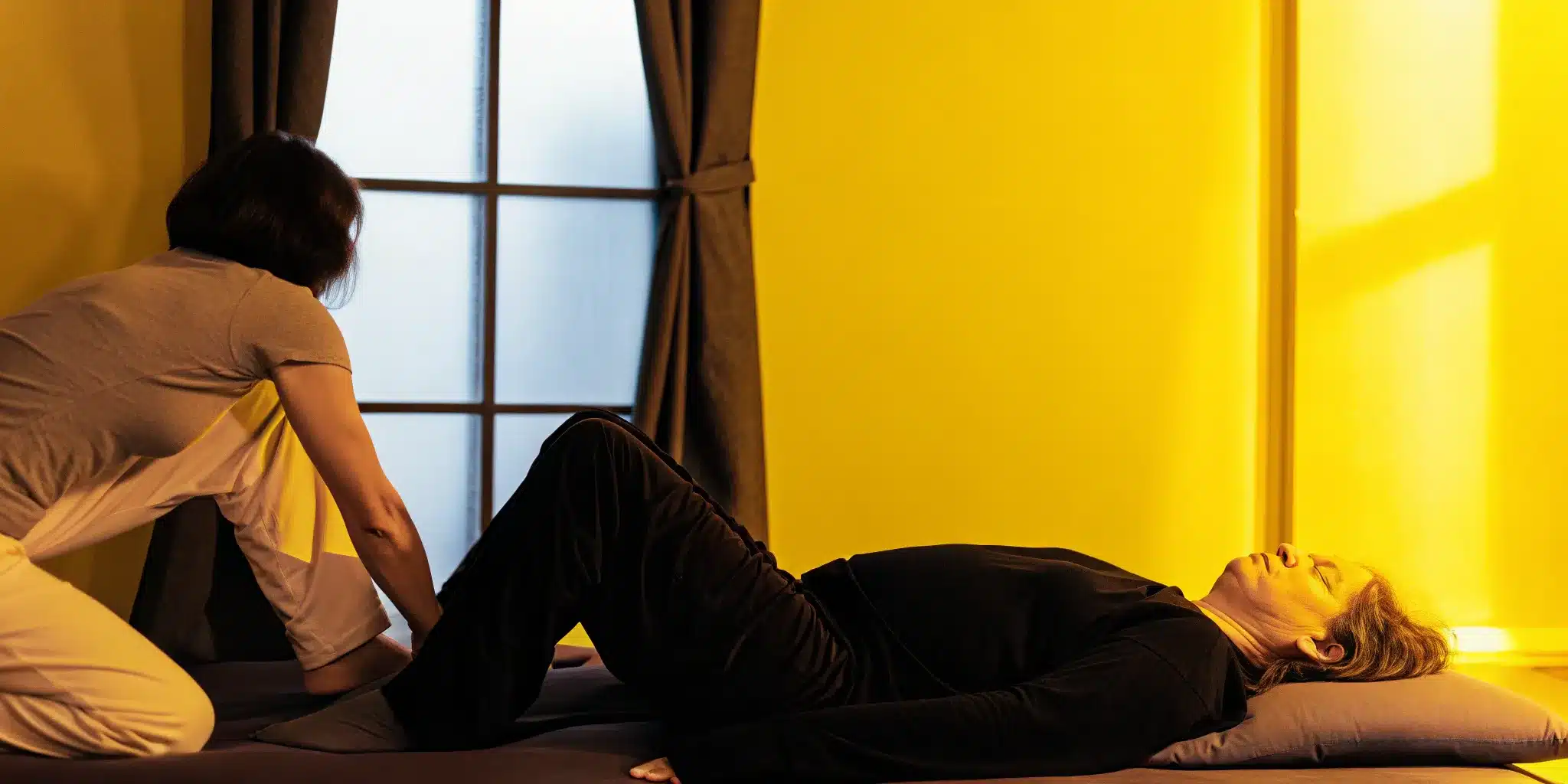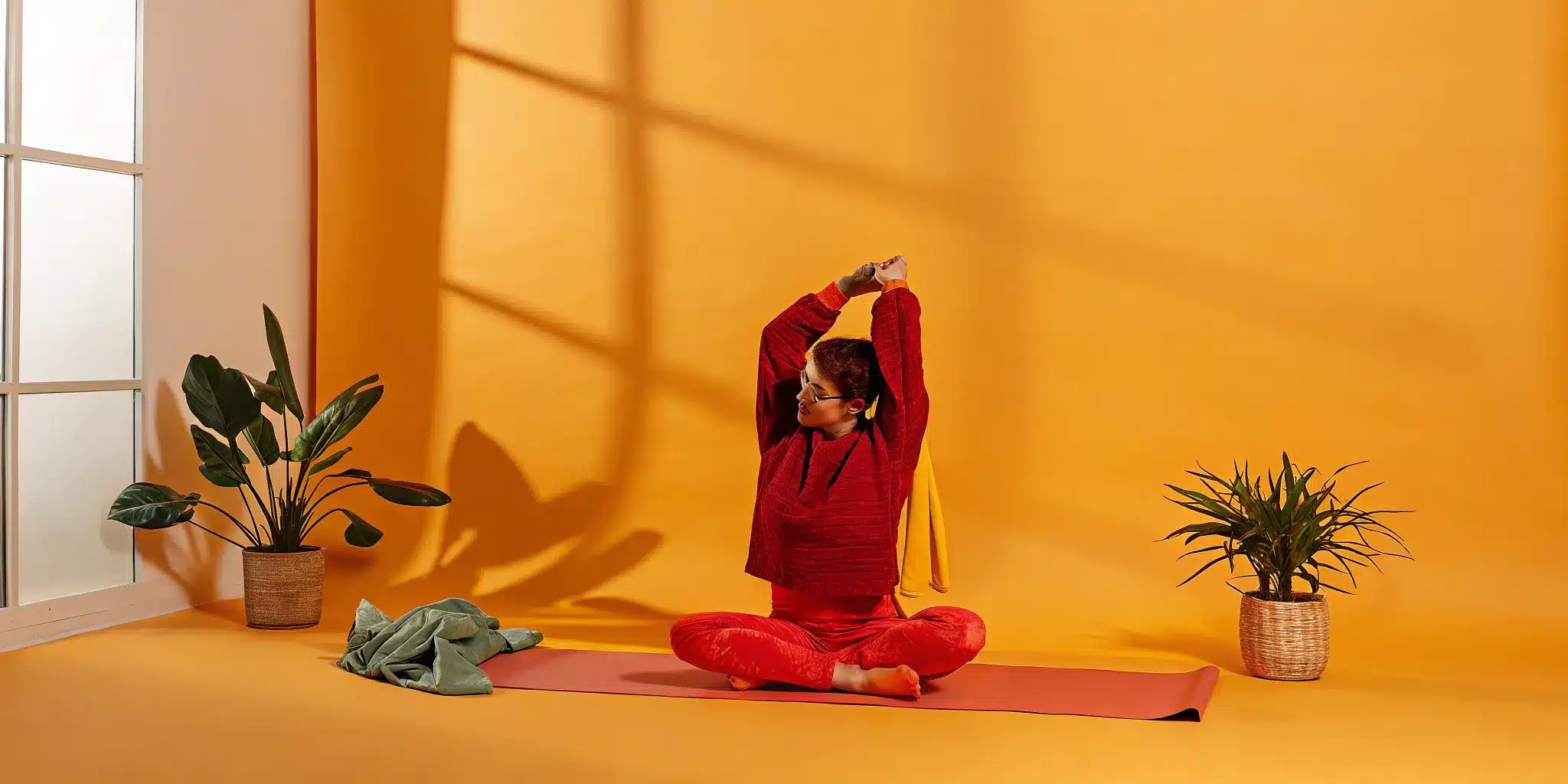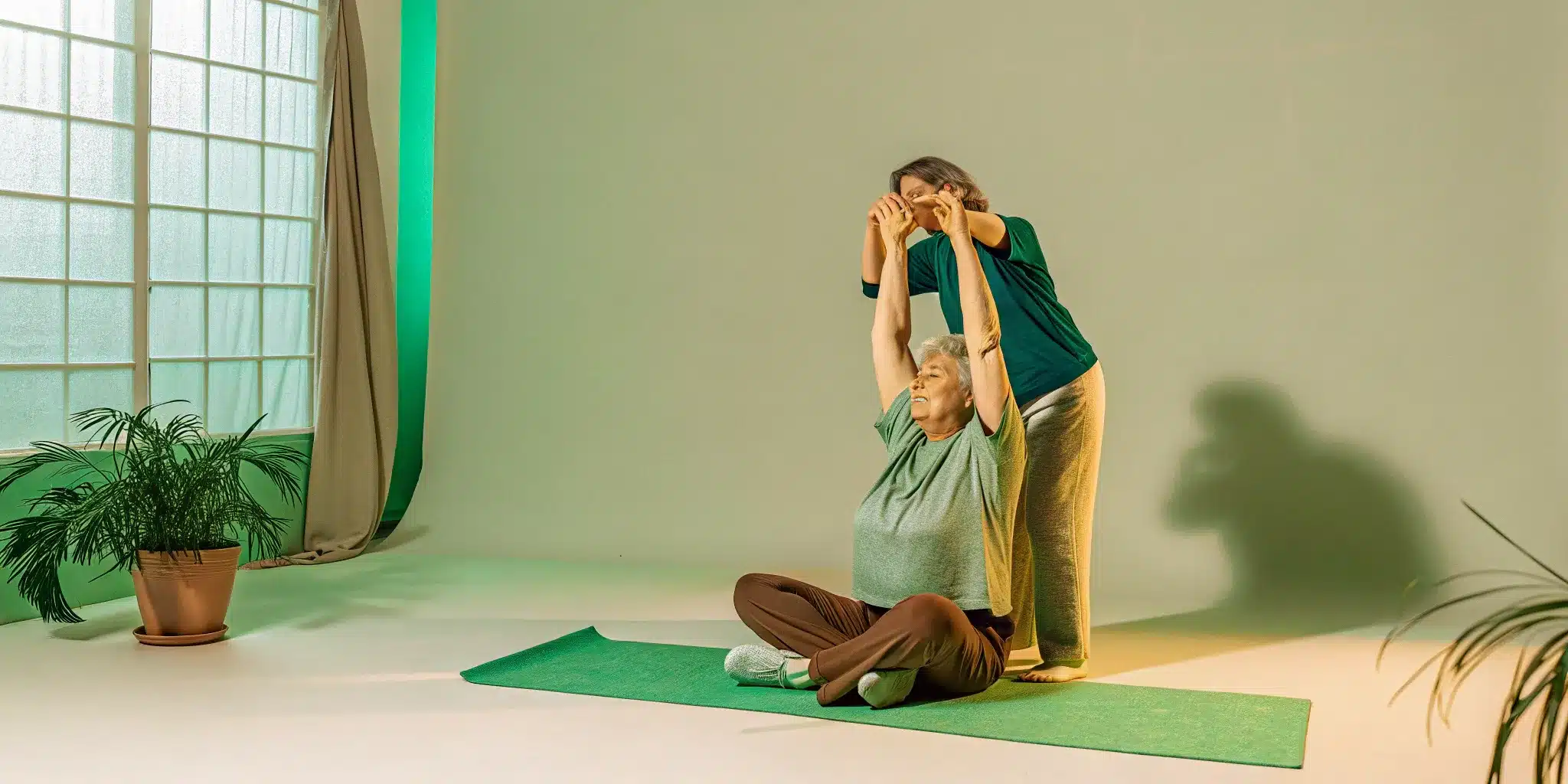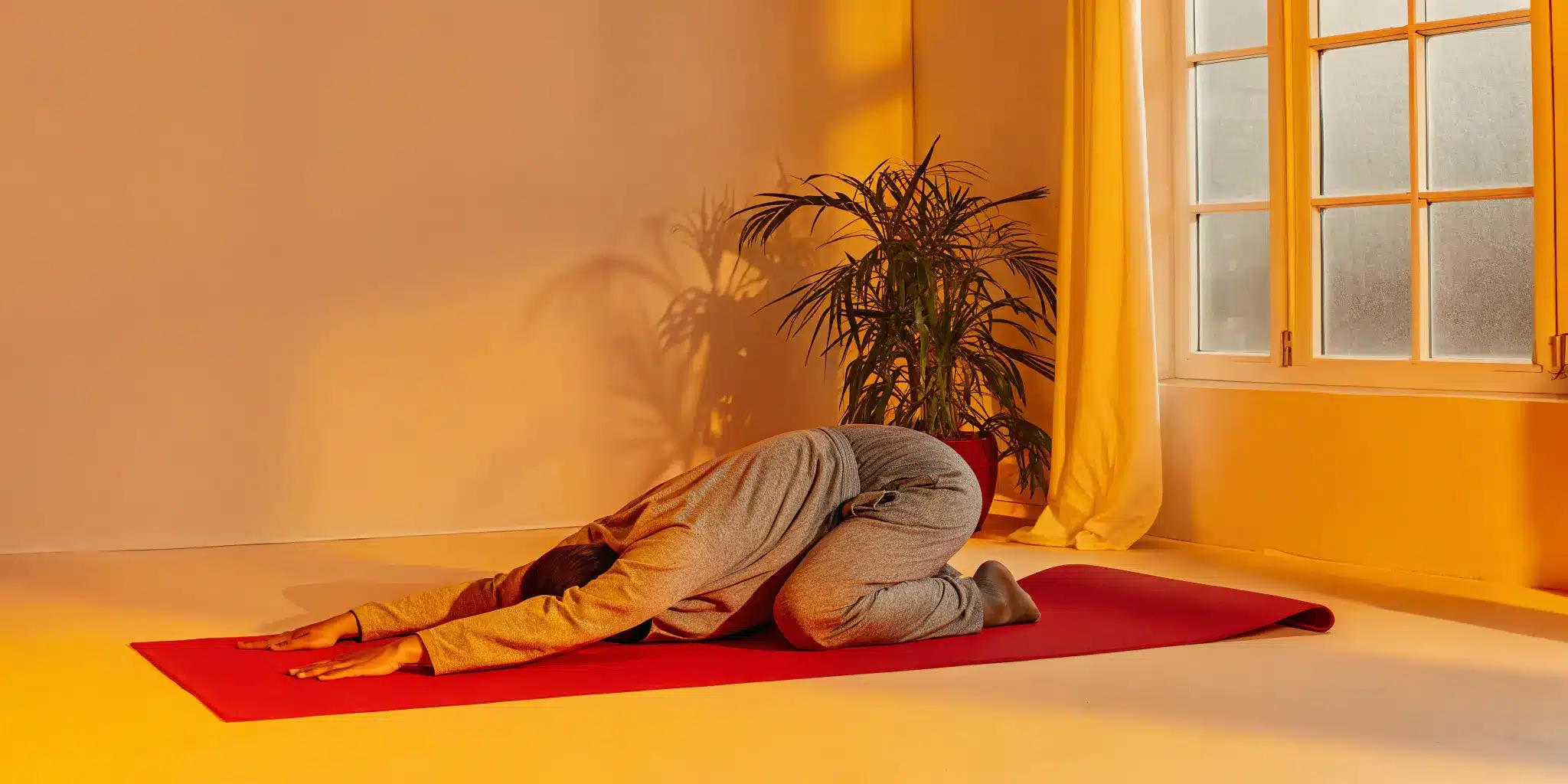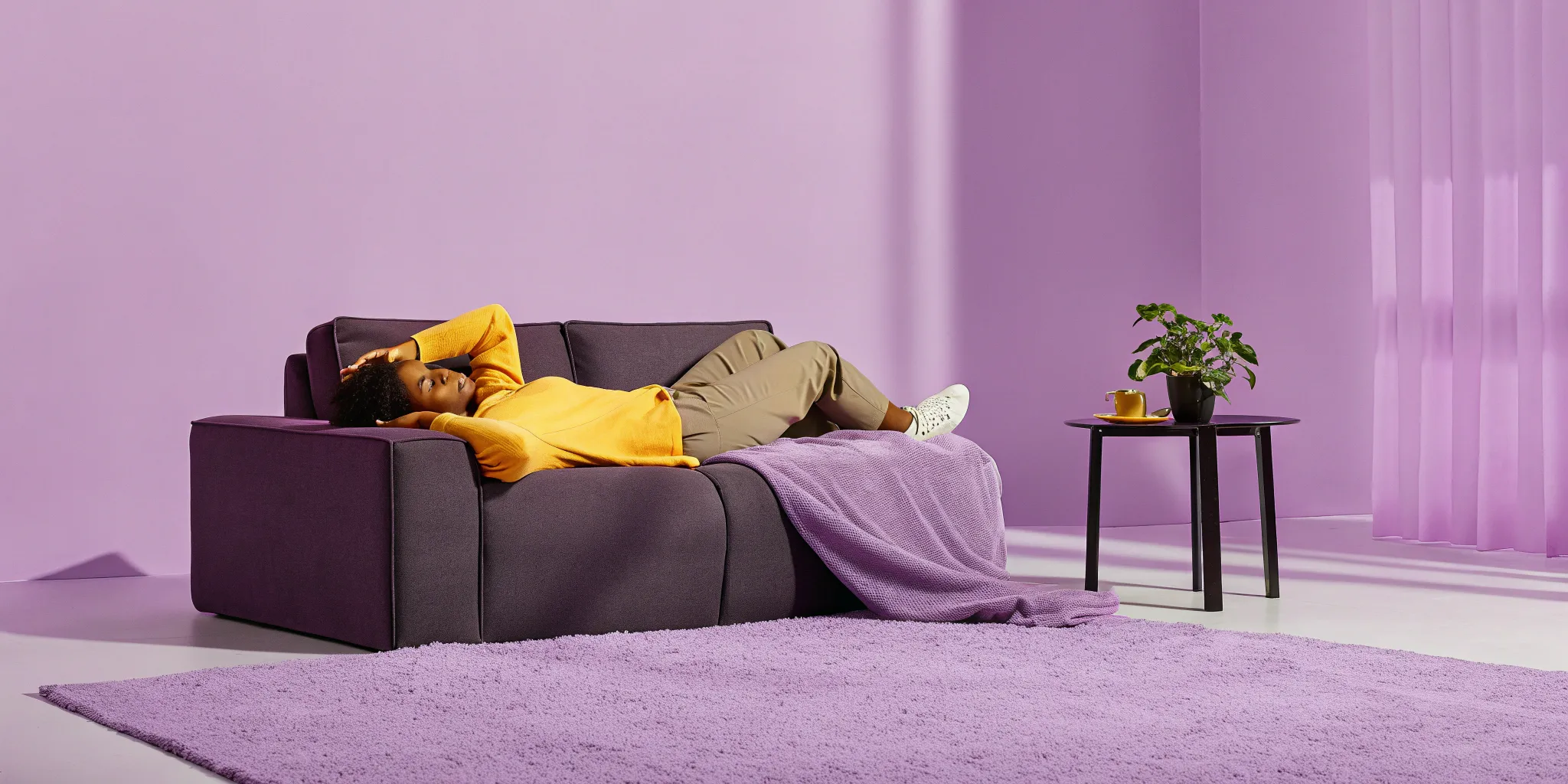If you’ve ever wondered why your lower back feels like a tightly wound coil, you’re not alone. It’s one of the most common complaints, yet the reasons can be surprisingly complex. The issue might not even be your back itself, but a result of tight hips, weak core muscles, or even daily stress. Dealing with very tight lower back muscles means looking at the bigger picture. This article is your roadmap to understanding how your body works as a system. We’ll identify the common culprits behind the stiffness and provide a clear, step-by-step guide to help you feel more flexible, stable, and strong.
Key Takeaways
- Your Daily Habits Are Often the Culprit: Persistent lower back tightness rarely appears out of nowhere; it’s usually a result of everyday factors like prolonged sitting, muscle imbalances from tight hips and hamstrings, and a core that isn’t properly engaged to support your spine.
- Pair Stretching with Strengthening for Lasting Relief: While gentle stretches provide immediate relief for tight muscles, building strength in your core and glutes is the key to long-term prevention. A strong support system takes the pressure off your lower back.
- Incorporate Small, Consistent Changes into Your Day: You can prevent future tightness by making simple adjustments to your routine. Focus on taking regular movement breaks, lifting correctly with your legs, and optimizing your sleep position to keep your spine aligned.
Why Is My Lower Back So Tight?
That nagging, stiff feeling in your lower back can be more than just an annoyance—it can make it hard to bend, sit, or even just get comfortable. If you’re constantly wondering why your lower back feels wound up like a tight spring, you’re not alone. This is one of the most common complaints people have, and it rarely comes out of nowhere. Understanding the root cause is the first step toward finding lasting relief. Often, it’s a combination of your daily habits, your body’s mechanics, and even your stress levels. Let’s look at some of the most frequent reasons behind that persistent lower back tightness.
Overworking Your Muscles
Sometimes, a tight back is simply a sign that your muscles have been pushed too hard. Think about the last time you had a really intense workout, spent a weekend gardening, or helped a friend move. These activities can lead to muscle strains or sprains, which are common culprits behind low back pain. When you overwork the muscles supporting your spine, they can become inflamed and contract, leading to that familiar feeling of stiffness and soreness. It’s your body’s way of protecting itself from further injury, but it can leave you feeling locked up and uncomfortable for days.
The Problem with All-Day Sitting
If you have a desk job, your chair might be a major contributor to your back issues. Sitting for hours on end, especially if you tend to hunch forward, puts a tremendous amount of pressure on your spine. This constant compression can weaken your back muscles over time and reduce blood flow to the tissues in your spine. Poor posture adds to the problem, creating a perfect storm for a chronically stiff back. Your body wasn’t designed to stay in one position for eight hours a day, and that constant tightness is its way of telling you it needs more movement.
When Your Muscles Get Out of Balance
Your body works as a connected system, and when one part is out of sync, it can create a domino effect. This is especially true for your lower back. Muscles like your hamstrings (the back of your thighs) and hip flexors (the front of your hips) can become incredibly tight, particularly from lots of sitting. When these muscles are tight, they pull on your pelvis, which in turn changes how your spine works. This forces your lower back muscles to work overtime to keep you stable, leading to fatigue, strain, and that persistent feeling of tightness.
How Age and Stress Play a Role
As we get older, it’s natural for our core muscles to lose some of their strength. A weaker core means less support for your spine, so your body might try to compensate by tightening up the surrounding back muscles to create stability. This can lead to chronic stiffness and low back pain. On top of that, don’t underestimate the power of stress. When you’re feeling anxious or overwhelmed, your body often responds by tensing its muscles—and the lower back is a common place for that tension to build up. This physical reaction to emotional stress can create a cycle of tightness and discomfort.
Is Your Lower Back Too Tight? Here’s How to Tell
That feeling of a “tight” lower back can be tricky to pin down. Is it just a little stiff from sitting too long, or is it a sign of something more? Learning to read your body’s signals is the first step toward finding real relief. Sometimes, the tightness is a straightforward sign that your muscles are overworked and need a good stretch. Other times, it’s your body’s way of telling you that there’s an underlying imbalance that needs attention.
A tight lower back often comes with a side of low back pain, making it hard to move freely through your day. You might feel it when you bend over to tie your shoes or when you try to stand up after being seated for a while. Understanding the difference between everyday stiffness and a more persistent problem can help you decide whether to focus on self-care or seek professional advice. Below, we’ll walk through the common signs that point to tight back muscles and the red flags that mean it’s time to talk to a pro.
Common Signs of a Tight Lower Back
The most obvious sign of a tight lower back is a persistent, dull ache or stiffness that makes it difficult to stand up straight. You might also experience sharp, sudden muscle spasms that can be surprisingly painful. But the feeling isn’t always isolated to your back. Often, tightness in your lower back is connected to other muscle groups.
For example, chronically tight hamstrings (the muscles in the back of your thighs) and hip flexors (the muscles at the front of your hips) can pull on your pelvis. This tilt changes your posture and puts extra strain on your lumbar spine, leading to that familiar feeling of stiffness and discomfort. So, if you notice your hips and legs feel tight, too, it’s likely contributing to your back issues.
When to Pay Closer Attention
While most lower back tightness can be managed with stretching and lifestyle adjustments, some symptoms warrant a closer look. If your stiffness doesn’t improve after a week or two of gentle self-care or if the pain starts interfering with your daily activities, it’s a good idea to see a doctor. A professional can help you get an accurate diagnosis and a clear path forward.
Pay immediate attention if you experience any “red flag” symptoms. Call your doctor right away if intense back pain is accompanied by a fever, sudden weakness in your legs, numbness in your groin area, or a loss of bladder or bowel control. These can be signs of a more serious condition that requires prompt medical care. Don’t wait it out—getting a proper diagnosis is key.
Need Relief Now? Try These Stretches
When your lower back is screaming for a break, the last thing you want is a complicated routine. The good news is that you don’t need one. These simple, gentle stretches can be done right at home to help release tension and provide some much-needed relief. The key is to listen to your body, move slowly, and breathe through each movement. You might be surprised at how much better you can feel in just a few minutes. Remember, the goal here is gentle release, not to push yourself into more pain. Find a comfortable spot on the floor, take a deep breath, and let’s get started.
Knee-to-Chest Stretch
This is a classic for a reason—it’s a simple and incredibly effective way to ease tension in your lower back. Start by lying comfortably on your back with your knees bent and feet flat on the floor. Gently bring one knee up toward your chest, using your hands to pull it in until you feel a comfortable stretch. Hold it right there for about 15 to 30 seconds, focusing on your breath. Release and repeat with the other leg. For a deeper stretch that targets both sides, you can even bring both knees to your chest at the same time. It’s like giving your lower back a gentle hug.
Child’s Pose
Child’s Pose is a wonderfully restorative stretch that helps lengthen your entire spine. Begin on your hands and knees, then gently sit your hips back onto your heels. From there, fold forward, lowering your torso down between your knees and resting your forehead on the floor. You can either stretch your arms out long in front of you or rest them alongside your body. This pose isn’t just about the physical stretch; it’s also a chance to calm your mind. Focus on taking deep, slow breaths, feeling your back expand with each inhale. This is one of the most restorative yoga poses you can do for back tension.
Cat-Cow Stretch
Think of this stretch as a way to gently wake up your spine and improve its flexibility. Start on all fours, with your hands directly under your shoulders and your knees under your hips. As you inhale, drop your belly toward the floor and look up, lifting your tailbone—this is the “Cow” part. As you exhale, round your spine up toward the ceiling, tucking your chin to your chest, just like a cat stretching its back. The key is to move slowly and mindfully between these two positions, coordinating the movement with your breath. This gentle flow helps massage the spine and relieve built-up tension in your back muscles.
Figure Four Stretch
Sometimes, lower back tightness is actually coming from tight hips and glutes. The Figure Four stretch is perfect for targeting those areas. Lie on your back with both knees bent and your feet flat on the floor. Cross your right ankle over your left knee, creating a “4” shape with your legs. Now, gently reach through the space you’ve created and pull your left thigh toward your chest. You should feel a nice stretch in your right glute and hip. Hold for 20-30 seconds, breathing deeply, and then switch sides. Releasing tension in your hips can have a direct impact on relieving lower back pain.
Lying Trunk Rotation
This is a gentle twist that can feel amazing on a tight lower back. Lie on your back with your knees bent and your feet flat on the floor. Extend your arms straight out to your sides, forming a “T” shape with your body. Keeping your shoulders pressed firmly into the floor, slowly let both of your knees fall to one side. Hold this gentle twist for a few breaths, feeling the stretch along your side and lower back. Then, engage your core to bring your knees back to the center and repeat on the other side. This movement helps to gently increase mobility in your spine without putting any strain on it.
Supine Hamstring Stretch
Did you know that tight hamstrings are a common culprit behind lower back pain? This stretch helps to release them. Lie on your back with both knees bent. Grab a towel or a yoga strap and loop it around the ball of one foot. Holding the ends of the towel, gently straighten that leg up toward the ceiling until you feel a stretch in the back of your thigh. Keep a slight bend in your knee to avoid locking it. As Harvard Health explains, keeping your hamstrings flexible is crucial for a healthy back. Hold for 30 seconds, then slowly lower your leg and switch to the other side.
Build a Stronger, More Flexible Back With These Exercises
Stretching offers fantastic, immediate relief for a tight back, but building strength is your long-term strategy for preventing that tightness from coming back. When the muscles that support your spine—like your core, glutes, and hips—are strong and engaged, your lower back doesn’t have to carry the entire load. These simple, effective exercises will help you build a solid foundation for a healthier, more resilient back. They don’t require any equipment and are perfect for adding to your daily routine.
Strengthen Your Core for Better Support
Think of your core as a natural corset for your spine. When these muscles are strong, they provide stability for your lower back. As we age or spend a lot of time sitting, our core can weaken. To compensate, your body might tighten other muscles, like those in your lower back, which can lead to aches and stiffness. Building core strength is one of the best things you can do for back health. It’s not about getting a six-pack; it’s about creating a stable center that supports your every move, from lifting groceries to simply standing up straight. A strong core helps distribute weight evenly, taking pressure off your delicate spinal structures.
Activate Your Glutes with Bridges
Your glutes are powerful muscles that are supposed to do a lot of the heavy lifting when you move. But if they’re not firing properly (a common issue for desk workers), your lower back often takes over, leading to strain and tightness. The glute bridge is a fantastic exercise to wake them up. To do it, lie on your back with your knees bent and feet flat on the floor. Gently lift your hips until your body forms a straight line from your shoulders to your knees. Squeeze your glutes at the top and hold for a moment before slowly lowering back down. This move strengthens your glutes, hamstrings, and core, teaching them to work together to support your lower back.
Release Tight Hips
You might be surprised to learn that your tight hips could be the real culprit behind your back pain. Your hip flexors are a group of muscles that connect your upper leg to your lower back. When you sit for long periods, these muscles can become short and tight, pulling on your spine and causing stiffness. Releasing this tension can make a world of difference. A simple kneeling hip flexor stretch is a great place to start. Kneel on one knee (use a cushion for comfort) with your other foot forward. Gently push your hips forward until you feel a stretch in the front of your hip. Stretching these muscles helps them lengthen, reducing the pull on your back.
Try a Back-Friendly Plank
Planks are famous for being a core-crusher, but they’re also an excellent way to build strength without putting excess strain on your spine. Unlike crunches, which can sometimes aggravate a sensitive back, planks engage your entire core in a neutral position. To perform a plank, get into a push-up position, either on your hands or forearms. The key is to keep your body in a perfectly straight line from your head to your heels. Engage your core by pulling your belly button toward your spine and squeeze your glutes. If a full plank is too much, start on your knees. Holding this position helps build endurance in the muscles that stabilize your back.
How to Keep Your Lower Back From Getting Tight
Once you’ve found some relief, the next step is to prevent that tightness from coming back. The best way to do that is by making small, mindful adjustments to your daily habits. You don’t need a major life overhaul to protect your back. Instead, focus on how you move, sit, and sleep. These simple changes can make a huge difference in keeping your lower back feeling loose, flexible, and pain-free. By being more aware of your body throughout the day, you can stop tightness before it even starts, letting you focus on the activities you love.
Lift Smarter, Not Harder
We all have to lift things, whether it’s a heavy box, a bag of groceries, or a toddler. But how you lift matters. The golden rule is to always lift with your legs, not your back. When you bend over at the waist, you put immense strain on your lower back muscles and spine. Instead, get close to the object, bend your knees into a squat, and keep your back straight as you power up with your legs. Hold the item close to your body to maintain your center of gravity and avoid twisting your torso as you lift or carry it. This simple technique helps you relieve low back pain by distributing the weight to your strongest muscles.
Take Breaks and Check Your Posture
If you work at a desk, you know how easy it is for hours to fly by without you ever leaving your chair. Unfortunately, prolonged sitting is a major cause of lower back tightness. Your muscles get stiff, and your posture starts to suffer. To combat this, set a reminder to get up and move around for a few minutes at least every half hour. Walk to get some water, do a quick stretch, or just stand up. When you are sitting or standing, be mindful of your posture. Try to sit up straight with your shoulders back and relaxed, avoiding the temptation to slouch. Good posture is one of the simplest ways to avoid a stiff back.
Set Up an Ergonomic Workspace
Your workspace should support you, not strain you. An ergonomic setup can prevent the slouching and muscle tension that lead to a tight lower back. Start with your chair. Adjust it so your feet can rest flat on the floor with your knees at a 90-degree angle. Your chair should also support the natural curve of your lower back. If it doesn’t, roll up a small towel or use a lumbar pillow to fill the gap. This simple fix helps maintain proper spinal alignment and reduces the changes of trunk muscle stiffness that can come from poor posture. Make sure your monitor is at eye level so you aren’t craning your neck down.
Adjust Your Sleeping Position
You spend about a third of your life sleeping, so your position in bed has a huge impact on your back health. The goal is to keep your spine in a neutral, straight line from your head to your hips. If you’re a side sleeper, place a pillow between your knees to prevent your top leg from pulling your spine out of alignment. If you sleep on your back, a small pillow under your knees can help maintain the natural curve of your lower back. The right pillow for your head is also key—it should support your neck without tilting your head up or down. These adjustments help prevent the morning stiffness that often signals back pain.
Lifestyle Habits for a Healthy Lower Back
Beyond specific stretches and exercises, your daily habits play a huge role in your back health. Think of these as the foundation that supports all your other efforts. Small, consistent changes in how you move, manage stress, and fuel your body can make a world of difference in preventing and relieving lower back tightness. By weaving these practices into your routine, you’re not just treating the symptoms—you’re building a more resilient back for the long haul. It’s about creating a lifestyle that keeps you moving freely and feeling your best.
Incorporate Daily Movement and Cardio
When your back is tight, the last thing you might want to do is move, but gentle activity is one of the best things for it. Your back muscles need good circulation and strength to function properly. This is where aerobic exercise comes in. You don’t need to run a marathon; a brisk 20- to 30-minute walk each day can work wonders. Walking gets your blood flowing, strengthens the muscles that support your spine, and helps keep your joints fluid. The key is consistency. Find an activity you enjoy, whether it’s walking, swimming, or cycling, and make it a non-negotiable part of your day. Your back will thank you for it.
Use Heat and Cold Therapy
Knowing whether to use heat or ice can feel confusing, but it’s pretty simple. Think of it this way: heat is for relaxing, and cold is for calming. If you’re dealing with chronic stiffness or arthritis-like aches, a warm pack or a hot shower can help. The warmth increases blood flow and soothes tight muscles. On the other hand, if you’ve overdone it at the gym or have a new injury, a cold pack is your friend. The cold helps reduce swelling and numbs the area for immediate relief. Having both a heating pad and a cold pack on hand means you’re always prepared to give your back what it needs.
Manage Stress to Relax Your Muscles
Have you ever noticed your shoulders creeping up toward your ears when you’re stressed? Your lower back does the same thing, tensing up without you even realizing it. High stress is a major contributor to muscle tightness. Finding healthy ways to manage it is crucial for your back health. This doesn’t have to be complicated. Try taking a few slow, deep breaths when you feel overwhelmed. Spend a few minutes outside, call a friend you love talking to, or jot down a few things you’re grateful for. These small acts can signal to your nervous system that it’s okay to relax, allowing your back muscles to release their grip.
Stay Hydrated and Eat Well
What you put into your body directly impacts your spine. The spongy discs between your spinal bones that act as shock absorbers are largely made of water. As we age, these discs can lose water and shrink, leading to stiffness. Staying well-hydrated throughout the day helps keep them plump and healthy. Similarly, a balanced diet rich in anti-inflammatory foods can help reduce overall pain and stiffness. Maintaining a healthy weight also takes a significant amount of pressure off your lower back. Simple swaps, like drinking an extra glass of water and adding more leafy greens to your plate, are powerful steps toward a healthier spine.
When Should You Seek Professional Help?
While the stretches and exercises we’ve covered can work wonders, sometimes your body needs a more expert touch. Listening to your body is key, and that includes knowing when to call in a professional for guidance and support. It’s not a sign of failure—it’s a smart step toward feeling your best and finding a solution that truly works for you.
Red Flags That Mean It’s Time to See a Pro
If you’re trying stretches at home and your pain is severe or seems to be getting worse, it’s time to check in with a doctor. They can help you get a proper diagnosis. You should also seek professional guidance if you have a diagnosed back condition, like spinal stenosis, to ensure you’re doing movements that are safe and beneficial for your specific situation.
Pay close attention to any new, intense back pain that comes with other symptoms. According to Harvard Health, you should call your doctor immediately if you experience fever, sudden weakness in your legs, numbness in your groin area, or difficulty controlling your bladder or bowels, as these could indicate a more serious issue.
The Benefits of 1-on-1 Assisted Stretching
You don’t have to wait for a red flag to get professional help. If you’re dealing with chronic tightness and pain, working with a specialist can make a huge difference. A trained professional, like a physical therapist or stretch practitioner, can create a personalized stretching program tailored to your body’s specific needs. They can identify which muscles are truly the source of the problem and guide you through movements safely and effectively.
With assisted stretching, an expert does the work for you, helping you achieve a deeper, more effective stretch than you could on your own. This hands-on approach ensures you’re using the correct form, preventing injury, and finally getting relief in those hard-to-reach spots. It’s a fantastic way to improve mobility and find lasting relief.
Create Your Daily Routine for Lower Back Relief
Consistency is your best friend when it comes to managing lower back tightness. You don’t need an hour-long yoga class every day to feel better. By weaving small, intentional movements into your morning, workday, and evening, you can create a simple yet powerful routine that keeps your back happy and mobile. Here’s how to get started.
Your 5-Minute Morning Mobility Routine
Start your day by gently waking up your spine. A few minutes of movement can make a world of difference in how you feel. Begin on your hands and knees for a few rounds of Cat-Cow. Inhale as you drop your belly and look up, then exhale as you round your spine toward the ceiling. This simple flow helps increase flexibility and eases morning stiffness. Next, roll onto your back for a Knee-to-Chest stretch. Gently pull one knee toward your chest, holding for 20-30 seconds before switching sides. This helps release tension built up overnight.
Simple Stretches to Do at Your Desk
If you have a desk job, your back is probably begging for a break by midday. Sitting for long periods, even with perfect posture, can cause muscles to stiffen. The key is to move for a few minutes every half hour. You don’t even have to leave your workspace. Try a standing Child’s Pose: stand a few feet from your desk, place your hands on the surface, and hinge at your hips, keeping your back straight. You’ll feel a gentle stretch through your lower back and hamstrings. A simple seated spinal twist can also work wonders for releasing tension.
How to Wind Down and Release Tension at Night
Winding down at night is the perfect time to release any tension you’ve accumulated throughout the day. A classic Child’s Pose is fantastic for this. Kneel on the floor, sit back on your heels, and fold your torso forward, resting your forehead on the mat. Extend your arms in front of you or rest them alongside your body. Breathe deeply into your lower back. Making stretching a regular part of your nightly routine is one of the best ways to keep pain from returning. It calms your nervous system and prepares your body for a restorative night’s sleep.
Related Articles
- Sleep Better: How to Relieve Lower Back Pain While Sleeping – STRETCHMED
- How to Release Chronically Tight Muscles for Relief – STRETCHMED
- 7 Morning Stretches for Lower Back Pain Relief – STRETCHMED
Frequently Asked Questions
Is it okay to stretch if my back is already hurting? This is a great question, and the answer is to listen carefully to your body. Gentle stretching can be incredibly helpful for relieving the dull ache of muscle tightness. The goal is to feel a mild release, not sharp pain. If a stretch causes any shooting, stabbing, or intense pain, you should stop immediately. Think of it as the difference between a “good hurt” that feels productive and a “bad hurt” that signals your body is in distress. When in doubt, always be more gentle than you think you need to be.
How often should I be doing these stretches and exercises to see a difference? Consistency is far more important than intensity. For the gentle stretches, try to incorporate them into your daily routine, even for just five minutes in the morning and five minutes before bed. This helps maintain flexibility and prevent stiffness from setting in. For the strengthening exercises like glute bridges and planks, aim to do them two to three times a week. This gives your muscles time to recover and build strength, creating a more supportive foundation for your back over time.
My back feels tightest in the morning. Is there a specific reason for that? Waking up with a stiff back is incredibly common. During the night, your body is still for long periods, which can cause muscles and connective tissues to tighten up. Your sleeping position also plays a huge role; if your spine isn’t properly aligned, it can put strain on your lower back muscles for hours. This is why a brief morning mobility routine, like a few rounds of Cat-Cow, can feel so good—it helps reintroduce movement and flexibility to your spine after a long rest.
Will stretching alone be enough to get rid of my back tightness for good? Stretching is a fantastic tool for immediate relief and improving your flexibility, but it’s only one piece of the puzzle. For long-term results, you need to pair it with strengthening exercises. Think of it this way: stretching helps release the tension you currently have, while strengthening your core, glutes, and hips builds a support system that prevents your lower back from having to do all the work in the first place. Combining both is the most effective strategy for keeping tightness from coming back.
I’ve tried stretching on my own, but it doesn’t seem to help. What’s next? It can be frustrating when you’re putting in the effort and not getting the relief you need. Sometimes, the true source of tightness is a muscle group you aren’t effectively reaching on your own, or an underlying imbalance that’s tricky to identify. If you feel stuck, seeking professional guidance is a great next step. Working with a stretch practitioner can make a huge difference, as they can provide an expert assessment and use hands-on techniques to help you achieve a deeper, more effective stretch safely.

